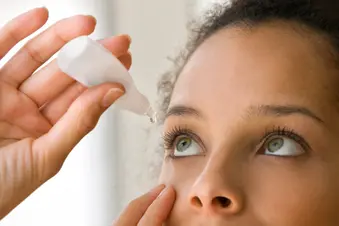
Dry eye is more than just uncomfortable. It can hurt your vision. Treatments and some simple actions can bring welcome relief to your sore eyes.
Add More Tears
Your natural tears bathe and soothe your eyes every time you blink. If you don’t make enough tears or they evaporate too quickly, your eyes get dry. They can get infected and the surface of your eye can get damaged if dry eye isn’t treated.
Eye drops called artificial tears mimic your real ones. They’re usually what doctors suggest first. You can choose from lots of over-the-counter brands at the drugstore. You may have to try a few before you find one that works for you.
Drops come with or without preservatives. If you use artificial tears four or more times a day, choose one without. Preservatives can irritate your eyes.
Artificial tears also come in thicker gels and ointments. Use these if the regular drops don’t do the trick. Use them before bed because the thick liquid can blur your vision.
Prescription Meds
Sometimes, artificial tears aren’t enough and dry eye is long-lasting (chronic). Your doctor may suggest cyclosporine (Cequa, Restasis) drops. This medicine helps make more of your own tears by calming inflammation in the tear glands.
You’ll use it twice a day. It may take up to 6 months to work, but initially may cause some irritation.
A new eye drop called lifitegrast (Xiidra) also curbs inflammation and can improve signs and symptoms of dry eye. You use these drops twice a day, too. You may get relief in as little as 2 weeks.
If your dry eye is serious, you might need steroid eye drops to ease inflammation quickly. You’ll use these for just a short time.
Plug Your Tear Ducts
Your eye doctor may suggest blocking your tear ducts so your eyes stay moist longer. Tiny plugs are put into the ducts at the inside corner of your eyes. These slow down tears from draining into your nose. Instead, they stay on the surface of your eye. The plugs can be taken out later or left in long term.
Or your doctor may recommend surgery to permanently close the ducts.
Change Your Diet
Flax oil -- omega-3 fatty acids -- may help dry eye in some people. It can help the glands that make the oily part of tears work better. Oil in tears keeps them from evaporating too quickly.
Warm Your Peepers
Sometimes, the oil glands at the edge of your lids get inflamed and clogged with hardened oil. Heat can melt it so it can flow freely again. Apply a warm wet washcloth to the area for 30 seconds up to 4 minutes. Do this twice a day when you have symptoms and once a day to keep the problem from coming back.
Eye Massage
This can help push the inflamed melted oil out of the glands. Here’s how to do it:
- With your eyes closed, gently massage your lids by rolling your index finger in a circular motion.
- Or get a cotton swab and roll it down your upper lid toward the lashes and the edge of the lid.
- To massage the lower lids, move your finger or swab up toward your lash line.
- Repeat this 5-10 times.
Clean Your Lids
This can get rid of dried oil or other gunk that’s blocking the gland. Dip a cotton swab into diluted baby shampoo and gently clean along the lash line on your top and bottom lids. Do this once a day. There are also over the counter eyelid cleaners like OcuSoft lid scrubs that you can use.
Add Moisture
Use a humidifier to add moisture to indoor air -- especially during the winter. Your eyes won’t dry out as quickly.
Lessen Your Screen Time
Using your computer, smartphone, or tablet can dry out your peepers. That’s because you blink less when your eyes are fixed onto a screen.
Follow the 20/20/20 rule. Take a 20-second break from your digital device every 20 minutes and look at something 20 feet away.
Use artificial tears if you feel symptoms of dry eye while using your devices.
Change Your Contacts
If your contact lenses make your eyes feel dry, your doctor may switch to a different kind. Or they may suggest wearing them for fewer hours. You may need to wear glasses if the dryness is serious.
Shade Your Eyes
Wind and the sun can zap moisture from your eyes. Wear wraparound sunglasses to protect them from the elements.
Show Sources
SOURCES:
National Eye Institute: “Facts about Dry Eye.”
National Health Service: “Dry eye syndrome -- Treatment,” “Dry eye syndrome -- Self-help.”
American Optometric Association: “Dry Eye,” “20/20/20 to Prevent Digital Eye Strain.”
American Academy of Ophthalmology: “Dry Eye Treatment,” “Can Fish Oil Help Dry Eye?”
Harvard Medical School: “Dry Eyes? Finding the Right Lubricating Drops Is Essential,” “Dry Eye Syndrome,” “Dry Eyes and What You Can Try.”
Johns Hopkins Lupus Center: “Restasis (Dry Eye Medication).”
FDA: “FDA approves new medication for dry eye disease.”
American Heart Association: “Fish and Omega-3 Fatty Acids.”
American Association for Pediatric Ophthalmology and Strabismus: “Meibomian Gland Dysfunction and Treatment.”